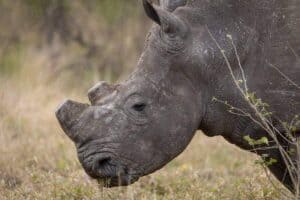It could also ‘stop prices from going up as it offers more supply into market’.

Legalising international trade in rhino horn could help the war against poaching, according to environmental resource economist Michael ’t Sas-Rolfes.
And part of the proceeds from legal trade could be used for the conservation of the animals. But, said ’t Sas-Rolfes, it needed to be done the right way, with a lot of things put in place for the laws to work properly.
“It’s not just a case of changing the laws and not only changing the laws in SA. The Convention on International Trade in Endangered Species (Cites) needs to be changed and also domestic laws in consumer countries,” said ’t Sas-Rolfes.
“So there would have to be a coordinated way of doing it and in a sense that there would need to be mechanisms to make sure that illegally obtained product could not be introduced into supply channels.”
He also said there were two main reasons in principles why legalising could help, the one reason would be that it could stop the price from potentially going up, as it offers more supply into the market. It would stop the pressure on markets, which would make it less profitable for poachers and illegal traders.
ALSO READ: Experts puzzled by elephant’s death due to human form of TB
“The other reason is that the people who are selling the horns legally could use that money for security, antipoaching and rhino conservation and that is a very important point that everybody usually misses,” he said.
“It would provide more money for the antipoaching and also enable the legal sellers to compete with poachers and illegal sellers. At the moment, they can’t.”
This after the South African National Parks’ (SANParks) large mammal ecologist Dr Sam Ferreira said the trends in the population of rhinos in the Kruger was not looking good, especially because of poaching.
“Ever since we introduced them in the 1960s – remember there were no rhinos in Kruger – and they did very well up to about 2010. Since then, the illegal activities associated with rhinos has driven the numbers down.”
However, Ferreira said although that was the case in the national park, in other parks rhinos were actually doing very well, and the population had increased. He said the reason the rhino population was going down was due to moving the animals to other facilities and the drought that happened in 2016, which hindered some of the animals from conceiving and fewer were born.
“South Africa can sell the horns inside the country, so we can trade among each other but there is no market,” he told the media.
“If you want to trade internationally, that is dictated by an international agreement called the Convention on International Trade in Endangered Species, which convention can put restrictions on how a country can trade. And currently the trade of horns is not allowed internationally.”
SANParks spokesperson Isaac Phaahla said at the peak, the Kruger had an estimated 15 000 to 16 000 rhinos and there had been a steady decline since 2008. The population is estimated at 3 500.






